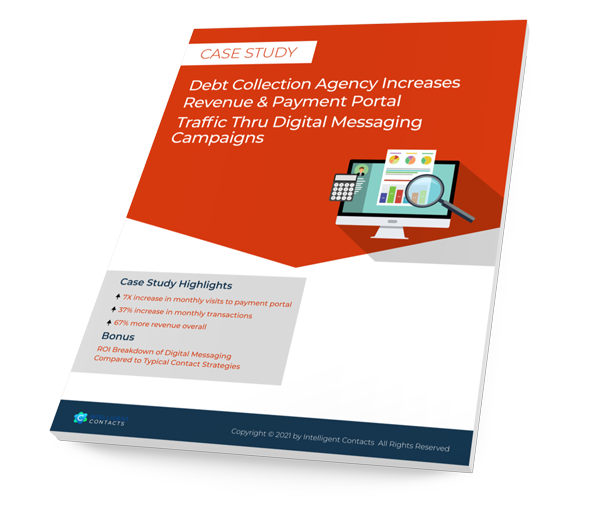STATEMENTS | 10 MIN READ
How Speech Analytics and Automated Agent Scorecards Improve Agent Results and Reduce Compliance Risks

Collection agencies work tirelessly to achieve the best outcomes for their clients.
Every day, they make difficult decisions about which debts to pursue and how to go about recovering them. One of the most important factors of an effective collection process is the ongoing training and evaluation of contact center agents.
Contact center software is great at reporting results and outcomes. For example, the total number of calls each agent took, average call duration, or how much revenue was collected. This data can identify the best or worst-performing agents, but it won’t tell a supervisor why. It also can’t measure overall call quality and customer satisfaction.
To accomplish this, the calls themselves need to be reviewed. This is typically done by listening to the call recordings or monitoring the live calls in progress. Both of these options are either impractical, or depending on the size of the contact center, impossible.
Automated scorecards are an advanced feature made possible through speech analytics—a technology that uses AI and machine learning to turn call recordings into actionable data. Powered by machine learning, every conversation can be automatically scored based upon the rules defined by the company.
What defines a “an effective automated agent scorecard” will differ according to the business needs of each organization, but when properly designed and implemented, dramatically increase agent effectiveness and reduce compliance risks.
In this whitepaper, we’ll walk you through the process of creating a scorecard that meets your specific needs. We’ll also provide some tips on how to optimize its performance.
- Reduction in Labor & Expense of Call Monitoring 80%
- Cuts Average Time to Locate a Consumer Dispute from 14 to less than 1 minute 8%
What is an Automated Scorecard?
Automated scorecards allow technology to do what’s traditionally been done manually by supervisors one call at a time. Automated scorecards use keywords and keyword lists to auto-answer crucial questions about every call.
- Did the agent read the “mini-miranda” to the consumer?
- Did they tell the consumer that call was being recorded?
- Did the agent, or the consumer, use profanity or threatening language?
- Did the agent verify right party contact before discussing a debt?
- Did the agent communicate any additional information required by the business?
Instead of relying on subjective judgment, automated scorecards assess how an agent performs into specific, objective measurements.
- FDCPA and CFPB compliance
- Script adherence
- Consumer-agent sentiment analysis
- Customer satisfaction and verification of client SLAs
- Agent training and performance monitoring at scale
Not only do automated scorecards provide managers with clear, actionable information about how an agent is doing; they also allow managers to quickly isolate and flag problematic calls across a contact center.
For example, an automated scorecard can be used to flag any call where profanity or other prohibited language is used.
Manual Scorecards vs. Automated Scorecards
Using scorecards to assess agent performance has historically been a manual process where a supervisor manually answers a series of questions based on reveiwing a recording of a call.
This process is tedious and time-consuming. In fact, manual scoring is often done overnight using offshore services. Outsourcing this process is costly and oftentimes untrustworthy.
Automated scorecards also eliminate the potential for personal bias. The technology assesses each call and agent based upon the same criteria.
Monitoring Agent Activity By Exception
Automated scorecards allow supervisors to monitor calls by exception. Instead of listening to every call looking for a “needle in a haystack, a supervisor is free to only review flagged calls.
This strategy of managing by exception is really only possible through the speech analytics technology and the use of automated scoring.
Understanding the Role of AI and Machine Learning
Building effective automated scorecard starts by understanding the basics of how speech analytics works.
Speech analytics uses AI and machine-learning processes to turn call recordings into actionable data.
Using Speech Analytics to Redact Sensitive Consumer Information
Recording contact center calls is crucial for ongoing agent training. But retaining call recordings are also necessary if a company needs to prove what was said during a conversation if legally challenged. However, storing call recordings comes with its’ own set of compliance risks when sensitive consumer information is being shared.
Through speech analytics, sensitive information like credit card or social security numbers can be identified and scrubbed automatically before the recordings are ever stored. When redacted, sensitive information in the call’s audio file is removed.
This process allows companies to compliantly store calls without risking the consequences of a data breach or future lawsuit.
Using Speech Analytics for Sentiment Analysis
Speech analytics uses keywords and keyword lists to create a separate sentiment analysis of both the agent and consumer’s conversation. This gives supervisors an indication of whether the overall sentiment of a call is positive or negative.
Sentiment analysis is helpful to assess individual calls, but also can be used to aggregate an agent’s sentiment across all the calls he or she has placed or received.
The 4 Steps of Speech Analytics & Machine Learning
Steps 1 and 2 of this process are refined and improved over time as more data is fed through the computing engines. This process improves the accuracy of transcriptions by allowing computers to learn regional dialects and specific variations in how agents pronounce certain words.
It also helps computers add important contextual data points necessary to customize its analysis to different business needs.



1
Transcription
Both channels (agent & consumer) are transcribed through proprietary algorithms that continually improve over time through machine learning.
2
Analysis
The transcriptions and call metadata are further analyzed, tagged, and categorized based upon processing rules setup during implementation.
3
Conversion
The processing results are converted into an ingestible format.
4
Presentation
The processing data is presented in a dashboard format that can be easily searched, understood, and acted upon by the supervisor.
1
Transcription
Both channels (agent & consumer) are transcribed through proprietary algorithms that continually improve over time through machine learning.
2
Analysis
The transcriptions and call metadata are further analyzed, tagged, and categorized based upon processing rules setup during implementation.
3
Conversion
The processing results are converted into an ingestible format.
4
Presentation
The processing data is presented in a dashboard format that can be easily searched, understood, and acted upon by the supervisor.
In Conclusion
Speech analytics and automated agent scorecards help supervisors track and manage agent performance and compliance by flagging problem calls quickly.
Leveraging the power of machine learning, recorded calls are processed, labeled, categorized, and scored to streamline the call quality process.
Speech analytics provides contact centers three major tools to improve agent performance and reduce compliance risks:
- Call Flagging
- Automated Agent Scorecards
- Sentiment Analysis
- Redaction of sensitive consumer data from call recordings
CASE STUDY
A leading third-party accounts receivables company was searching for a more profitable way to engage consumers with special discounts and settlement offers.


5 KPI Metrics You Should Be Tracking
Is your company missing its’ revenue numbers and you have no idea why? Well-defined KPIs allow owners to measure and track the underlying operational objectives critical to business success.
Want to know more?
Whether you’re looking to upgrade one part of your communication or payment process or the whole enchilada, we can help!






